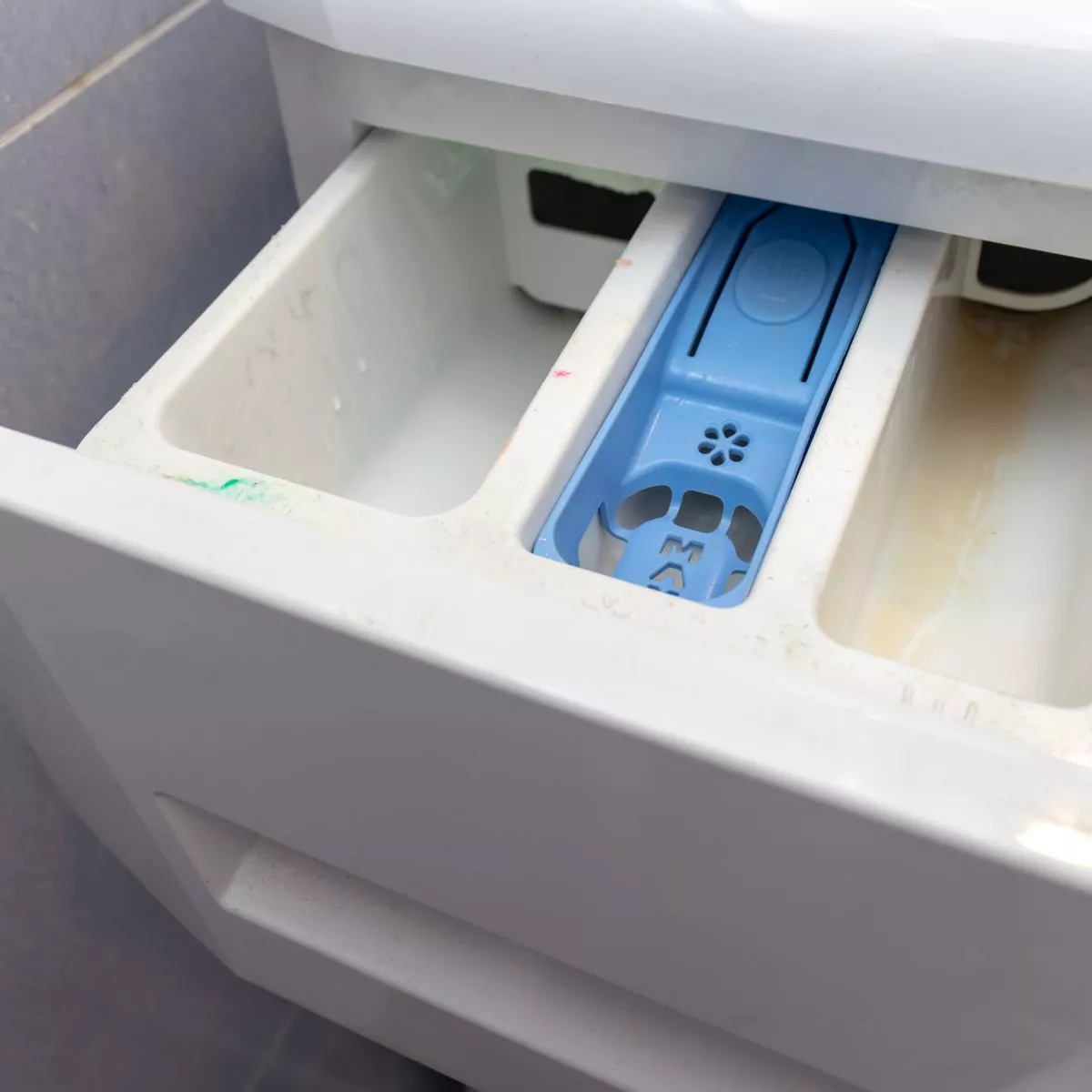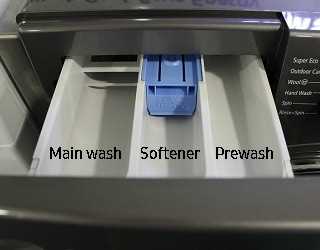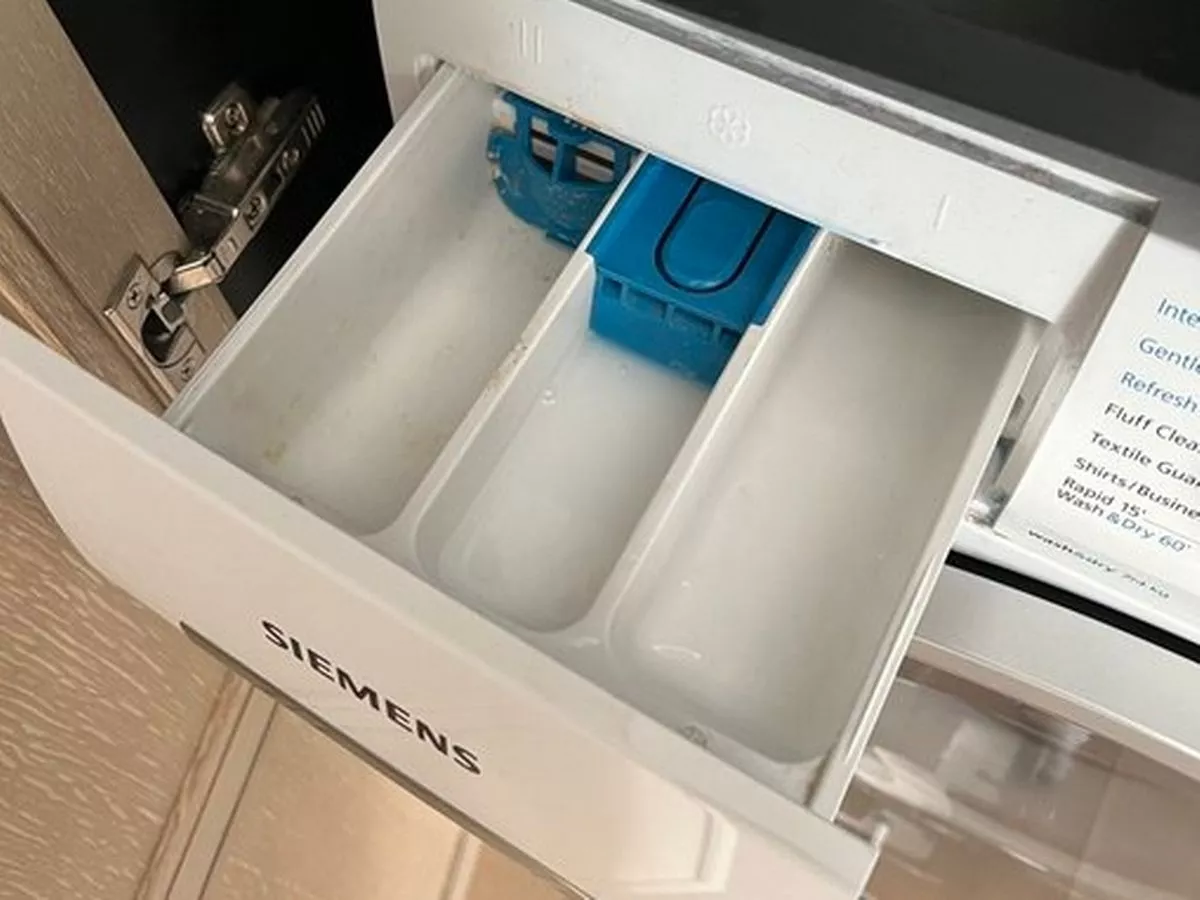




If you’ve ever looked closely at the detergent drawer of your washing machine, you may have noticed that it is divided into three compartments. These compartments play a crucial role in the washing process, ensuring that the right products are dispensed at the right time. Understanding how each compartment works can help you achieve the best results when doing your laundry.
The first compartment, often labeled with a symbol representing a pre-wash or soak, is designed for pre-soaking heavily stained or soiled items. This compartment allows you to add a detergent specifically formulated to break down tough stains and dirt before the main wash cycle begins. By pre-soaking your clothes, you give the detergent time to work its magic and remove stubborn stains more effectively.
The second compartment, typically labeled with a symbol representing the main wash cycle, is where you add your main detergent. This detergent is responsible for removing everyday dirt and grime from your clothes. It is essential to choose a detergent that suits your laundry needs, whether it’s for sensitive skin, high-efficiency machines, or specific fabric types. The main wash compartment ensures that the detergent is dispensed at the right time during the wash cycle, guaranteeing clean and fresh-smelling clothes.
The third compartment, often labeled with a symbol representing fabric softener or conditioner, is where you add your fabric softener or conditioner. This compartment is designed to release these products during the final rinse cycle. Fabric softener helps to make your clothes feel softer and more comfortable to wear, while conditioner can help protect and prolong the life of your garments. By using the fabric softener or conditioner compartment, you can ensure that your clothes come out of the wash feeling and smelling great.
Understanding the role of the three compartments in your washing machine drawer can greatly improve your laundry results. By using each compartment correctly and choosing the right products, you can achieve cleaner, fresher, and softer clothes with minimal effort.
What is a washing machine drawer?

A washing machine drawer is a compartment located in the front of a washing machine where users can add detergent, fabric softener, and other laundry additives. It is typically divided into three separate compartments, each serving a specific function during the wash cycle.
Main compartments:
- Detergent compartment: This is the largest compartment in the washing machine drawer and is used to add laundry detergent. It is usually marked with a symbol or label indicating where to pour the detergent.
- Fabric softener compartment: Smaller and typically located next to the detergent compartment, this section is used for adding fabric softener. It helps to soften clothes and reduce static during the wash cycle.
Additional compartments:
- Bleach compartment: Some washing machine drawers have a separate compartment for bleach. This allows users to add bleach to the wash cycle without it coming into direct contact with the clothes.
Overall, the washing machine drawer offers a convenient and organized way to add detergent, fabric softener, and other additives to the wash cycle. It is important to follow the manufacturer’s instructions and guidelines for proper usage of the compartments to ensure optimal cleaning results.
The Role of the Three Compartments
The washing machine drawer is an essential part of the appliance that allows for the proper distribution of detergent, fabric softener, and bleach during the washing cycle. Understanding the role of each compartment in the washing machine drawer is important to ensure that your clothes are effectively cleaned and cared for.
Main Detergent Compartment
The main detergent compartment is typically the largest and most prominent one in the washing machine drawer. It is designed to hold powdered or liquid laundry detergent and is often marked with a symbol or label indicating its purpose. This compartment is responsible for holding the detergent that cleans your clothes and removes stains and dirt.
When using the main detergent compartment, it is important to follow the manufacturer’s instructions regarding the amount of detergent to use for each load of laundry. Using too much detergent can leave residues on your clothes or result in excessive sudsing, while using too little may not effectively clean your garments.
Fabric Softener Compartment
The fabric softener compartment is typically located next to the main detergent compartment and is easily distinguishable by its smaller size and separate opening. This compartment is used to hold fabric softener, which is designed to make your clothes feel softer, reduce static cling, and provide a pleasant scent.
To use the fabric softener compartment, simply pour the recommended amount of fabric softener into the designated area. During the rinse cycle, the washing machine will release the fabric softener into the wash, ensuring that it is evenly distributed throughout the load.
Bleach Compartment
The bleach compartment, also known as the bleach dispenser, is typically located in a separate compartment or drawer within the washing machine. It is specifically designed for holding bleach, which is a powerful cleaning agent that helps to remove tough stains and brighten white garments.
When using the bleach compartment, it is important to follow the manufacturer’s instructions for the correct concentration of bleach to use and to avoid using bleach with fabrics that are not bleach-safe. It is also a good idea to check the washing machine’s specific guidelines for using bleach, as some machines may require additional steps or precautions.
Using the bleach compartment helps to ensure that bleach is dispensed at the appropriate time during the washing cycle, preventing damage to your clothes and the washing machine itself.
Conclusion
The three compartments in your washing machine drawer play distinct roles in the cleaning and care of your clothes. The main detergent compartment cleans your clothes, the fabric softener compartment makes them softer and reduces static, and the bleach compartment helps remove tough stains and brighten whites. Taking the time to understand how these compartments work and properly using them will result in cleaner, fresher, and better cared for laundry.
Detergent Compartment
The detergent compartment is one of the three compartments in your washing machine’s drawer that is used for the main detergent. It is specifically designed to hold the detergent, ensuring that it is dispensed at the right time during the wash cycle.
How to Use:
- Read the instructions on the detergent packaging to determine the correct amount of detergent to use for your load of laundry.
- Open the detergent compartment by pulling it out or pressing a button, depending on the design of your washing machine.
- Pour the recommended amount of detergent into the compartment. Be careful not to overfill it, as this can lead to excessive foaming and poor washing results.
- Close the compartment until it clicks into place, ensuring that it is securely sealed.
Tips:
- Use the appropriate type of detergent for your laundry needs, such as liquid detergent for everyday clothes or specialized detergents for delicates or stains.
- If you prefer using laundry pods or capsules, place them directly into the drum of the washing machine instead of the detergent compartment.
- Regularly clean the detergent compartment to remove any residue or buildup, as this can affect the performance of your washing machine.
Additional Information:
In some washing machines, the detergent compartment may have multiple sections or markings, indicating different detergent types or additional additives, such as fabric softener or bleach. Refer to your washing machine’s manual to understand the specific functionality and use of each section.
It is important to follow the instructions provided by the washing machine manufacturer and the detergent manufacturer to ensure effective and safe use of the detergent compartment.
Softener Compartment
The softener compartment in your washing machine is specifically designed to hold fabric softener during the rinse cycle. Fabric softener helps to make your clothes feel softer and reduces static cling.
Here are some important things to note about the softener compartment in your washing machine:
- Location: The softener compartment is typically located next to the detergent compartment in the washing machine drawer.
- Usage: When you add fabric softener to the softener compartment, it will be automatically dispensed during the rinse cycle.
- Amount: Follow the instructions on the fabric softener bottle to determine the appropriate amount to use. It’s important not to overfill the compartment.
- Cleaning: It’s advisable to clean the softener compartment regularly to prevent buildup and ensure proper dispensing. You can remove the compartment and rinse it with warm water to remove any residue.
It’s worth noting that not all washing machines have a dedicated softener compartment. Some models may require you to manually add fabric softener during the rinse cycle.
Using fabric softener in your washing machine can help to maintain the softness and freshness of your clothes. By following the instructions and properly using the softener compartment, you can enhance your laundry experience.
Bleach Compartment
The bleach compartment in your washing machine drawer is specifically designed to hold bleach during the wash cycle. Adding bleach to your laundry can help remove stubborn stains and brighten whites. However, it’s important to use bleach carefully and follow the manufacturer’s instructions to avoid damage to your clothes or washing machine.
How to use the bleach compartment:
- Check the care label on your clothes to ensure they can be safely bleached.
- Measure the appropriate amount of bleach according to the instructions on the bleach bottle or your washing machine’s manual.
- Pour the bleach into the bleach compartment in your washing machine drawer.
- Close the drawer and start the wash cycle as usual.
Tips for using bleach in your washing machine:
- Use bleach sparingly and only when necessary, as it can weaken fibers over time.
- Do not mix bleach with other cleaning agents or detergents, as this can create dangerous chemical reactions.
- Make sure to fully close the bleach compartment after adding bleach to prevent spills or accidents.
- Always follow the manufacturer’s instructions for your specific washing machine and bleach product.
- Consider using color-safe bleach for colored or delicate fabrics, as regular bleach can cause fading or damage.
By using the bleach compartment in your washing machine drawer correctly, you can effectively incorporate bleach into your laundry routine and achieve cleaner and brighter results.
How to Properly Use the Washing Machine Drawer
Using the washing machine drawer correctly is essential for achieving the best results when doing your laundry. Here are some steps to follow:
1. Read the Instruction Manual
Before using your washing machine, it’s important to familiarize yourself with its specific features and functions. Read the instruction manual to understand how to operate the machine and use the drawer effectively.
2. Separate Your Laundry
Prior to loading your washing machine, separate your laundry into different types of fabrics and colors. This will help you determine which compartment of the drawer to use for each specific item.
3. Identify the Compartments
Most washing machine drawers have three compartments labeled with symbols or numbers. These compartments are designed for detergent, fabric softener, and bleach. Familiarize yourself with the symbols or numbers to determine the purpose of each compartment.
4. Add Detergent to the Main Wash Compartment

Take the appropriate amount of detergent for your load and pour it into the main wash compartment. This is usually the largest compartment and is meant for washing powder or liquid detergent. Follow the detergent manufacturer’s instructions for the correct dosage.
5. Add Fabric Softener to the Softener Compartment
If you wish to use fabric softener, pour the recommended amount into the softener compartment. This compartment is typically marked with a flower-shaped symbol or number 2. Fabric softener helps keep your clothes soft and reduces static cling.
6. Use the Bleach Compartment if Necessary
If you need to use bleach for certain items, pour the appropriate amount into the bleach compartment. This compartment is usually marked with a triangle or number 3. Be sure to follow the instructions on the bleach packaging for the correct amount to use.
7. Close the Drawer and Start the Cycle
Once you have added the necessary detergents or additives, close the drawer securely. Then, select the desired wash cycle and start the machine. The washing machine will automatically dispense the detergents and fabric softener at the appropriate stages of the wash cycle.
8. Clean the Drawer Regularly
It’s important to clean the washing machine drawer regularly to prevent the buildup of detergent residue or fabric softener. Remove the drawer and rinse it with warm water to remove any leftover traces. Then, dry it thoroughly before reinserting it into the machine.
By following these simple steps, you can ensure you are using the washing machine drawer correctly and effectively for clean and fresh laundry every time.
Choosing the Right Detergent
When it comes to selecting the right detergent for your washing machine, there are a few factors you should consider.
Type of Fabric

The first thing to keep in mind is the type of fabric you will be washing. Different fabrics require different types of detergent. For delicate fabrics such as silk or wool, it is best to use a gentle detergent that is specifically designed for these types of materials. For everyday fabrics like cotton or polyester, a regular detergent should work fine.
Stain Removal
If you frequently deal with tough stains on your clothes, you may want to consider using a detergent that is specifically formulated for stain removal. These detergents often contain enzymes or active ingredients that help to break down and remove stubborn stains. Look for detergents that mention stain removal on the packaging.
Fragrance
If you prefer your clothes to have a fresh scent after washing, you may want to choose a detergent that offers a variety of fragrances. There are many options available, from floral to fruity scents. However, be aware that some people may have sensitivities or allergies to certain fragrances, so it’s always a good idea to test a small amount of detergent on a garment before using it on a full load.
Environmentally Friendly Options
If you are concerned about the impact of your detergent on the environment, you may want to consider using an environmentally friendly option. Look for detergents that are labeled as biodegradable, phosphate-free, or made from plant-based ingredients. These options are often better for the environment and can still provide effective cleaning power.
Choosing the Right Amount
Lastly, it’s important to use the right amount of detergent for each load. Using too much detergent can lead to excess suds, which may not rinse out properly and can leave residue on your clothes. On the other hand, using too little detergent may not clean your clothes effectively. It’s best to follow the manufacturer’s guidelines for the recommended amount of detergent to use.
By considering the type of fabric, stain removal capabilities, fragrance preferences, environmental impact, and using the right amount, you can choose the right detergent for your washing machine and ensure that your clothes are clean and fresh after every wash.
FAQ
Why does my washing machine have three compartments in the drawer?
The three compartments in your washing machine drawer serve different purposes. The first compartment is for pre-wash detergent, the second is for main wash detergent, and the third is for fabric softener. This allows you to add the appropriate products at the right time during the wash cycle.
What is the purpose of the pre-wash detergent compartment?
The pre-wash detergent compartment in your washing machine drawer is used for detergent that is specifically designed for pre-washing heavily soiled clothes. Adding detergent to this compartment ensures that it is dispensed at the right time during the wash cycle to effectively remove dirt and stains.
Can I use the main wash detergent in the pre-wash compartment?
No, you should not use the main wash detergent in the pre-wash compartment. The main wash detergent is formulated to be used during the main wash cycle, while the pre-wash detergent is designed for the pre-wash cycle. Using the wrong detergent in the pre-wash compartment may result in less effective cleaning.
Why should I use the fabric softener compartment in my washing machine?
The fabric softener compartment in your washing machine drawer is specifically designed for fabric softener. Adding fabric softener to this compartment ensures that it is dispensed during the rinse cycle, resulting in softer and more comfortable clothes. It also helps to reduce static and make ironing easier.
What happens if I don’t use the correct compartments in my washing machine drawer?
If you don’t use the correct compartments in your washing machine drawer, you may not get the desired results. Using the wrong compartment for detergent may result in less effective cleaning, while not using the fabric softener compartment may lead to clothes that are not as soft and may have more static. It is important to follow the manufacturer’s instructions and use the appropriate compartments for the best results.











